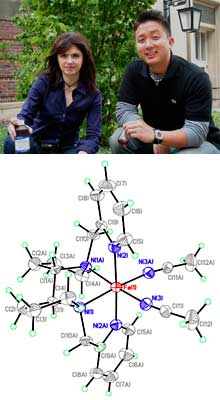Drugs That Are Easier on the Environment
A new environmentally friendly catalyst could make it much easier to discover new drugs based on natural sources. Researchers at the University of Illinois at Urbana-Champagne have shown that an iron-based catalyst could be used to turn promising natural products into effective medications by selectively altering complex molecules to make them more bioactive.

The catalyst could also streamline the process of synthesizing other drugs, reducing toxic waste in the form of heavy metals and chlorine. Christina White, a professor of chemistry at the University of Illinois who led the research, hopes that her work will benefit human health. She says that the new catalyst, described in the current issue of Science, could help companies “make drugs better and potentially discover drugs faster.”
Many of the most effective medications have been derived from natural sources, says Steve Brickner, a research fellow at Pfizer, based in New York, who is involved in drug discovery. “The bulk of antibiotics on the market come from natural products,” he says. “The ability to manipulate complex molecules of natural-product origin, as [White’s team has] done, is really very exciting.”
Using conventional techniques to sort through promising natural products can be an arduous process. A natural product, typically in the form of a complex molecule, may be too weak to be an effective drug. But changes to the core of the molecule could make it much more potent. The problem is that because the molecules are complex, and the target bonding sites are inert and difficult to modify specifically, even such a minor change can be difficult or impossible. As a result, chemists often have to synthesize the molecules from scratch, a cumbersome and complicated process. White’s catalyst lets researchers make specific changes to normally difficult-to-modify bonds in complex natural molecules, which could allow chemists to much more easily sort through possible new drugs. White demonstrated this capability by modifying artemisinin, a complex natural antimalarial compound, into a related compound that could prove more effective.
Brickner says that the catalyst may help researchers discover new drugs in another way. Chemists screen the metabolites that are produced when organisms process candidate drugs, and sometimes the metabolites could themselves be the basis for powerful drugs. With White’s catalyst, it may be much easier to work with such metabolites.
If certain types of new molecules must be synthesized from scratch, White’s process could also cut down on the number of steps required during the drug-discovery or manufacturing process. As chemists synthesize new molecules, they have to think ahead about what chemical groups the end product must contain, and decide at what point in the synthesis process they must be added. That’s because as the molecule becomes more complex at each step along the way, certain bonds become inaccessible. As a result, certain chemical groups can’t be added late in the process. Yet incorporating these functional groups early in the process can make it much more complicated, requiring researchers to incorporate extra steps to protect the group from subsequent chemical reactions. White’s catalyst makes it possible to add hydroxyl groups later in the process, potentially cutting more than five steps, Brickner says.
Joseph DeSimone, a professor of chemistry and chemical engineering at the University of North Carolina at Chapel Hill, says that by streamlining drug synthesis, White’s catalyst could reduce the use of toxic metals and other toxic chemicals such as chlorine. The catalyst itself is based on iron, a benign metal. Other catalyst systems can make heavy use of toxic metals.
While the new catalyst should prove useful for a wide range of molecules, it’s not a chemical panacea. It’s specifically geared for modifying a certain type of bond in a specific way: researchers using White’s catalyst can insert a hydroxyl group at specific carbon-hydrogen bonds.
In some cases, the sort of modifications possible with White’s catalyst can already be made using enzymes. But White says that her catalyst is cheaper and can be used to modify many more types of molecules than enzymes.
“Any chemist who saw this paper would be considering applications,” Brickner says.
Keep Reading
Most Popular
How scientists traced a mysterious covid case back to six toilets
When wastewater surveillance turns into a hunt for a single infected individual, the ethics get tricky.
The problem with plug-in hybrids? Their drivers.
Plug-in hybrids are often sold as a transition to EVs, but new data from Europe shows we’re still underestimating the emissions they produce.
What’s next for generative video
OpenAI's Sora has raised the bar for AI moviemaking. Here are four things to bear in mind as we wrap our heads around what's coming.
Stay connected
Get the latest updates from
MIT Technology Review
Discover special offers, top stories, upcoming events, and more.